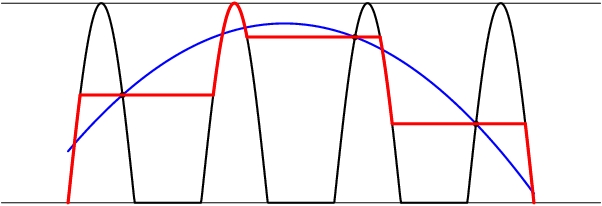Let's create a proof a la Koosis. All the techniques used below can be found in his book "The Logarithmic Integral".
Take $a>1$ and put $f(z)=a\prod_j(1+z/z_j)^{p_j}$. That is a nice analytic function and, while its absolute value is somewhat hard to understand, its argument is very simple: it is an $n$-piece piecewise linear function on the circle with slope $\frac 12 n$ (with respect to the usual circle length) and jumps at $z_j$. Let $I$ be the image of one of the arcs between two adjacent points $z_j$ and $z_{j+1}$ under the mapping $z\mapsto \operatorname{arg}f(z)$. We can transplant all functions defined on the circle arc $[z_j,z_{j+1}]$ to $I$ using this mapping. Note that the integral of any function over the arc with respect to the circle length is just $2/n$ times the integral of its transplant over $I$ with respect to the line length.
Let $\Phi$ be the transplant of $|f|$. Assume that $\Phi<2$ on $I$. The transplant of $f$ is then just $F(t)=\Phi(t)e^{it}$. The key observation is the following:
$$
\int_I \log|2-F(t)|dt\ge \log 2(|I|-\pi).
$$
Assuming that it is true, we conclude that the full integral of $\log|2-f|$ over the unit circle is at least $2/n$ times the sum of the right hand sides over the intervals corresponding to all arcs, which is $0$. On the other hand, if $a>1$, then $\log|2-f(0)|=\log|2-a|<0$, so $2-f$ must have a root inside the disk and the maximum principle finishes the story.
Now let us prove the observation claim. The only thing we really know about $\Phi$ is that it is log-concave and, thereby, unimodal. Fortunately, that's all we need. So, in what follows, $\Phi$ will be just any unimodal function on $I$ with values in $[0,2]$. Since we can always extend $\Phi$ by $0$ outside $I$, we can switch to any larger interval we want without making the inequality easier. So, WLOG, $I=[-2\pi n-\frac\pi 2,2\pi n+\frac\pi 2]$
Now, let us observe that for every fixed $t$, the integrand is minimized for $\Phi(t)=2\max(0,\cos t)$ (that is just the nearest point on the line) and that the farther we go away from this optimal value, the larger the integrand is. Therefore, to minimize the left hand side, we need to stay as close to the black regime on the picture (the graph of $2\cos_+ t$) as we can.

Suppose that the actual $\Phi$ is given by the blue line. Then, replacing $\Phi$ by the red line $\Psi$, we come closer to the optimum at every point. But the red line consists of several full periods (horizontal pieces) and several pieces that together constitute one full positive arc of $\cos t$. Now, each full period means running over some circle around the origin, so the average value of $\log|2-\Psi(t)e^{it}|$ over each full period is exactly $\log 2$. At last, the $2\cos t$ part gives $\int_0^\pi\log (2|\sin t|)dt=0$, which is exactly the loss of $\pi \log 2$ compared to $\log 2$ times its length $\pi$.
That's it. Feel free to comment and/or ask questions.

